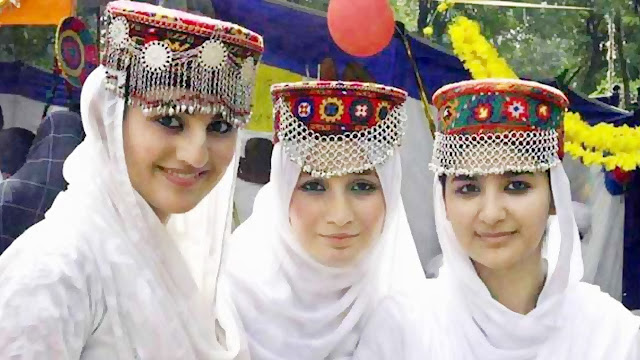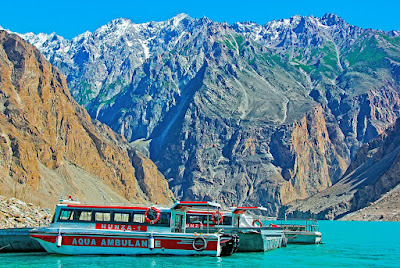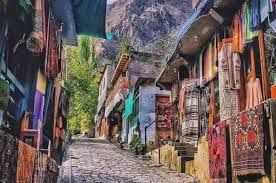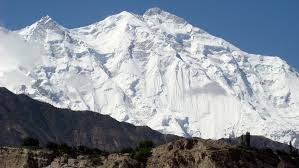Culture and Language
Hunza valley is famous for its culture, history, and various local languages are spoken by people who live here. the literacy rate is about 100 % which makes this valley more attractive to tourism.
The current of time has also given much importance to the history of Hunza. Before the formation of Pakistan, Hunza was a separate state with Karimabad as its capital.
Ancient trade caravans passed through this valley and traded with China and Central Asian countries. Caravans cross the rugged mountains on foot to bring valuables from Kashgar and China that are still part of the local tradition.
Urdu is the national language in Pakistan as well as in Hunza there are some local languages but most of these Brushaski is the most spoken language in the region.
People of Hunza valley are more beautiful as well as more hospitable, humble, and attractive as compare to other areas of the country.

Hunza Valley Location
When it comes to the gifts of beauty and colors, Allah Almighty has adorned this land of Pakistan with such beautiful scenery that the eye is amazed when it sees it.
The honor of embracing the beauty of the Northern Areas of Pakistan is carved on the rugged mountains by the highway known as the Karakoram Highway in Gilgit-Baltistan.
Located on the rocky mountains, the nine hundred and six-kilometer long Pakistan Highway is a great example of Pak-China friendship.
Every year thousands of tourists embrace the beauty of the North on this highway in the shadow of the height of the mountains.
Traveling on the Karakoram Highway, about one hundred and two kilometers from Gilgit, there appears a paradise of beauty surrounded by mountains. Its attraction attracts people from far and wide.
Rich in natural beauty there are two valleys Hunza and Nagar surrounded by towering mountains and icy peaks o all four sides so that these valleys take the form of lush bowls full of beautiful colors and fragrances. In the middle of which the river Hunza crawls away.
People of Hunza Valley
The natural beauty of the beautiful people of this beautiful valley lies in their innocence and politeness. Pearls of ancient tradition are hidden in them. The best weather, climate, not only because of the pure food and delicious fruits, the health of the people here is the best in Gilgit-Baltistan.
Even the people here live longer than the people of other areas. The way of life of the people here has changed a lot and this change is a beautiful combination of East and West with the combination of ancient civilization and modern culture.
 |
| Hunza People |
In this peaceful environment, women work alongside men and their actions reflect their confidence. Women make precious garments with their own hands, which are a major tourist attraction in the markets. Hunza's stone-carved bazaars have jewelry, antique precious utensils, the best products of cloth, as well as all kinds of equipment for mountaineering tourists.
Apricots and Cherries
The best varieties of dried apricots are also found in the bazaars or markets. There are 24 varieties of apricots in Hunza Nagar valley which are very famous for their excellent fragrance and taste.
Apricot orchards are scattered throughout the valley, which local women place on the roofs of their houses to make them dry. From where these delicious dried apricots are sent to other areas. Besides cherries, walnuts and vineyards are also found here and there. They keep the area fragrant all year round.
 |
| Dried Apricots |
Civilization and Tradition
These innocent-faced people who protect their scent live in small but beautiful houses made of stone and wood. The houses of the people here, which are layered on top of each other, are also very closely connected to each other like the hearts of the people here. It is evidence of their pacifism and love of ancient traditions.
History of Hunza Valley
The eight-hundred-year-old fort Baltit, built on solid rocks, is like a crown on top of the fortified houses of the Hunza Valley. Seeing this wants to pay homage to its architecture.
Fort Baltat, built on strong stone and wooden foundations, was the home of the people of the Hunza Valley called Meer. Sitting in this fort, Mir was in charge of the entire population. Peeking from here, Meer would realize that when one looks at this beautiful valley from these beautiful wooden windows, he will not feel the lack of anything in his estate.
There is a throne on the roof of the fort where Mir used to sit and listen to the problems of the people. One of the secrets of the beauty of this fort is that every angle looks different and unique.
It offers a spectacular view of the entire valley and the high mountains and snow-capped peaks that surround it. In which Rakaposhi is seen covered with snow all year round. Deran peak in Rakaposhi's side appears in the form of an ice lion.
 |
| Hunza Fort |
The last knock of the sun hits the Spontik peak and makes it a golden peak. Ulster, Lady Finger, and Hunza peak offer a beautiful view of the valley to their visitors. Spread out in this beautiful cluster of crawling clouds, these peaks are a testament to nature's bounty.
Another fort of Hunza valley is located on a slope is Altit. It is situated on the bank of river Hunza at a distance of 3 km from Karim Abad. This fort is 900 years old.
It is built on a very difficult rock under which the river Hunza can be seen bowing before its majesty. Seeing its construction, I would like to pay tribute to the courageous people of Hunza Valley. The Hunza River flows in front of Qila Altit and joins the Nagar River.
At the confluence of these two rivers, there is a beautiful village called Ganesh Abad. Monuments of ancient times, old mosques, forts, sculptures, and unfamiliar writings are scattered here and there.
Which seems to narrate the history of caravans, fighters, and religious followers passing through these areas centuries ago in the language of silence.
Famous Glaciers, Peaks in Hunza
There are some tracks to go to great glaciers from Nagar valley so trekkers can go to Baltoro, Beyafo, Hupper, and Haspar glaciers. These are the greatest and longest glaciers in the world as well as Rakaposhi and Passu Cones mountains play a vital role to promote tourism in the valley.
Lake Made by Natural Disaster
One of the famous lakes is Attabad Lake, which came out on the map of the world because of an unfortunate landslide in January 2010. at the distance of 14 km. from Karimabad, 19 km long road and a whole village fell into the Hunza River due to this terrible landslide.
The lake has emerged as a very popular tourist destination named Attabad Lake. It is a beautiful experience for tourists and locals to cross the 21 km long lake by boat and see the high mountains crawling at the foot of the green lake.
 |
| Lake Attabad |
Natural Beauty, Enchants its Tourists
The viewers will never forget this scene for the rest of their lives. The beauty of Hunza Nagar valley embraces the caravan of these colors and beautiful landscapes and embraces every traveler who comes here. Most of the tourists who visit Hunza travel to Khunjerab Pass as well. Because there are very beautiful and must-visit places on the way to Khunjerab Pass
High mountains all around, the fragrance flying from the foothills of soft and delicate flowers and the clear and transparent of these lakes adorned with beautiful colors, people with hearts and beautiful faces like water, the heavenly views of this beautiful valley create desire in the hearts of those who come here to live in this paradise forever.
 |
| Huza Bazar (Markets) |
 |
| Hunza Bazar (Markets) |
 |
| Hunza Antiques and Jewelry |
 |
| Rakaposhi Hunza |
